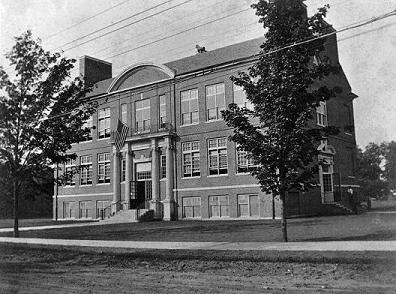
REPRINTS

Washington School opened April 12, 1915. What a relief it was, after coping with the terrible
school fire of October 1913, double sessions, and temporary arrangements,
while planning and construction took place.
A small paper-bound booklet "Annual Reports of the Selectmen and Town Officers," August 15, 1915, says that the
mid-year opening was difficult, but "the attention of every member of the faculty has been concentrated upon an attempt to
minimize� the loss to the pupils which it was felt would�ensue under the existing conditions. No faculty ever worked more
loyally or in a more altruistic spirit," and it was worth the disruption to get settled into new buildings.
Washington School was constructed for $62,237.56 by the Ninth School District, operating separately from the Board of
Education, which ran the other districts� schools. In 1933, the school districts consolidated, but, until then, the Annual
Reports refer to the Ninth District Committee and the Board of Education as two different organizations, with their own
staff and budgets.
The Ninth District was supported financially by Cheney Brothers, Manchester�s silk manufacturers and philanthropists,
although Cheneys didn�t actually build Washington School, as they did others in the southern part of town, notably the 1904
High School, now converted to apartments, and Bennet School, which opened in 1915. Cheney Brothers also sent over their
plumbers, painters, and carpenters from the nearby "Machine Shop" when maintenance was needed.
The 1915 report, available for research at the library of the Manchester Historical Society, lists four teachers at
Washington School, with the number of their registered pupils and average attendance:
L. Hanna, 45 registered, and 91.1 percent attendance
E. Woodworth, 39 registered, and 86.7 percent attendance
E. Borowski, 36 registered, and 87.4 percent attendance
H. Ransome, 40 registered, 89.5 percent attendance
Overall, Ninth-District attendance improved to 86.9 percent for the school year, from 85.9 percent the previous year.
One issue with attendance was "the enforcement of the rule in regard to vaccination," which prevented some pupils from
entering school, until they were "over age" for their grade. F. A. Verplanck, Superintendent in 1915, said that the Ninth
District was making a "determined effort" to reduce the number of over-age children, and to bring pupils "up to grade."
Verplanck notes some other reasons for below grade-level performance:
1. Pupils do not speak or understand English.
2. Indifference of parents in sending pupils to school regularly.
3. Illness.
4. Poor mentality.
5. Poor teaching.
Reports about truancy mention children "working" and "no clothes" as reasons for absenteeism. Verplanck says that a
considerable number of children have parents "indifferent as to whether they attend school or not. This attitude on the
part of the parent is soon well known to the pupil. The result is repeated absence with excuses which are often to be
looked upon with suspicion. This type of pupil soon becomes indifferent to the work of the school showing no ambition and
no interest. He interrupts and retards the work of the room and interferes with the advancement of the other pupils. The
only satisfactory way of dealing with this problem is to control the attendance of the pupil. This often can be done by
using the combined efforts of the teacher, the attendance officer, with the town court as a last resort."
But, overall, Verplanck is pleased with the 1914-1915 school year, and notes that, "The children of no school system
in the State attend school under better material conditions."
Gone are the historic days when we could build a school like Washington school for $62,237.56, and plan, fund,
construct, and open it in 18 months.
 This photo was taken by John Knoll (1887-1955), a prolific Manchester photographer. Millicent Koski, who loaned the photo
to the Manchester Historical Society, taught at Washington School for 25 years. Millie pointed out the horn on top of the school. This and other strategically placed horns
were part of Manchester�s communication system.
This photo was taken by John Knoll (1887-1955), a prolific Manchester photographer. Millicent Koski, who loaned the photo
to the Manchester Historical Society, taught at Washington School for 25 years. Millie pointed out the horn on top of the school. This and other strategically placed horns
were part of Manchester�s communication system.
Throughout Manchester, the horns would sound a series of blasts announcing
where there was a fire or other disaster. A single blast meant, "All clear." There was a chart translating the signals,
and frequently this chart was kept on the back of a closet or cellar door, to be consulted when the horns blew. Sometimes
the horns blew to alert everyone that a heavy snowstorm had cancelled school. As a former teacher, Millie remembers that
nine blasts meant, "No school today."
Note that Cedar Street, in front of
the school, is not paved.
Editor's note: Frank Farley, a member of the Cheney family, was the architect for Washington School. He also designed the "new" Town Hall at the Center, and the original part of the Mary Cheney Library on Main Street. Washington School, in the Landmark Historic District, was threatened with demolition in 2013 when the Town planned to replace it with a new school. The Historical Society was actively involved in protesting this destruction.
Susan Barlow is a Director Emerita of the Manchester Historical Society and serves as webmaster.